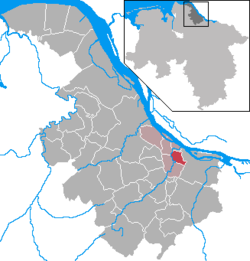Mittelnkirchen Mittelskark (Low Saxon) | |
|---|---|
 The Lühe river in Mittelnkirchen | |
Location of Mittelnkirchen within Stade district  | |
 Location of Mittelnkirchen | |
| Coordinates: 53°33′N9°37′E / 53.550°N 9.617°E | |
| Country | Germany |
| State | Lower Saxony |
| District | Stade |
| Municipal assoc. | Lühe |
| Government | |
| • Mayor | Joachim Streckwaldt (CDU) |
| Area | |
• Total | 7.02 km2 (2.71 sq mi) |
| Elevation | 1 m (3.3 ft) |
| Population (2023-12-31) [1] | |
• Total | 1,109 |
| • Density | 158/km2 (409/sq mi) |
| Time zone | UTC+01:00 (CET) |
| • Summer (DST) | UTC+02:00 (CEST) |
| Postal codes | 21720 |
| Dialling codes | 04142 |
| Vehicle registration | STD |
| Website | www.luehe-online.de |
Mittelnkirchen (in High German, in Low Saxon: Mittelskark) is a municipality in the district of Stade, Lower Saxony, Germany.




